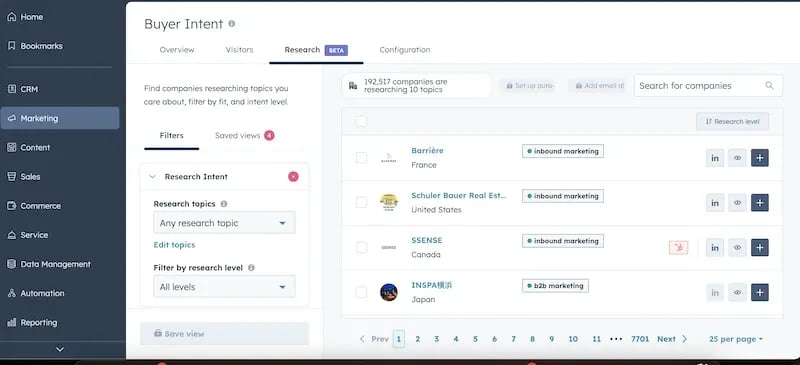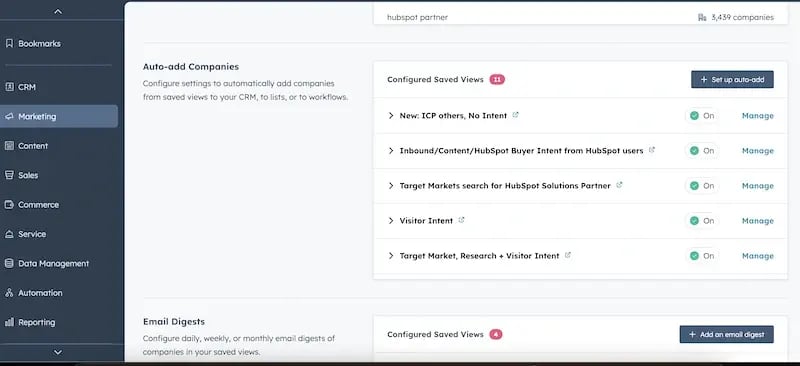B2B Prospecting - How Do I Leverage Research Intent?
Are you tired of playing a guessing game with your B2B prospecting efforts? In today's dynamic business landscape, identifying genuinely interested B2B prospects has become increasingly complex. While you might be driving traffic to your website, much of it often remains anonymous, leaving you to wonder about the true purpose behind each click.
The challenge is real: finding and engaging with decision-makers who are genuinely considering solutions like yours requires a more sophisticated approach. It's no longer about sheer volume but precision, relevance, and timing. You're certainly not alone if you struggle to consistently fill your pipeline with qualified leads. But powerful, data-driven methods are available to change that narrative.
We're not here to tell you how to find more prospects, but about discovering the right prospects. This article will delve into modern, practical strategies and powerful sources for identifying and attracting B2B leads in the research phase, helping you move beyond speculative outreach to strategic engagement. Our focus is research intent, a powerful signal that can redefine your business development efforts and unlock new growth.
Decoding Intent: Visitor or Researcher?
Understanding various forms of intent data can reveal precisely who actively seeks your solution or examines your competition. This isn't just a fantasy; it's a powerful reality. In B2B prospecting, differentiating between casual browsers and serious potential leads is crucial. It lets you focus your efforts and customize your outreach accurately, significantly boosting your business development results.
So, what's the difference? Visitor intent is about analyzing on-site browsing behavior to identify general interest. Tools like HubSpot's CRM and various analytics platforms track what pages visitors view, how long they spend on each page, their navigation path, and whether they make recurring visits. For instance, if a visitor repeatedly returns to your pricing page, product feature pages, and "About Us" section over several days, it's a strong signal of growing interest. They might not be ready to buy today, but they are clearly thinking about your products and are excellent candidates for nurturing through targeted content. This data allows you to segment your audience and tailor future communications, moving them closer to becoming a qualified lead.
Even more powerful for B2B prospecting is research intent, a crucial component of buyer intent data. This goes beyond general interest to identify specific signals that indicate a prospect is in an active buying cycle across the web. This could involve them researching specific topics, industry challenges, competitor websites, or performing specific searches for solutions that align with your product or service, even if they haven't visited your site yet. It's like knowing what someone is looking for before they knock on your door.
Tools like ZoomInfo, coupled with advanced features within platforms like HubSpot, aggregate this kind of intent data by monitoring digital footprints across a vast network of publisher sites, review platforms, and news outlets. According to ZoomInfo's Customer Impact Report, customers using their platform have reported notable improvements, including a reduction in sales cycles by up to 46 days and a significant increase in connect rates, often doubling from previous benchmarks.
For example, imagine that your sales team receives an alert that a specific company that fits your ideal customer profile has been actively researching "cloud migration solutions" and "data security platforms" on various industry forums and review sites in the last week. This is a powerful, pre-emptive insight. You can use this. Instead of a generic cold email, your sales representative can craft a highly personalized message that addresses their specific pain points around cloud security, perhaps offering a whitepaper on seamless, secure migration strategies or a case study of a similar client. This level of informed outreach is exponentially more effective.
Implementing Research Intent Tracking
To truly harness the power of research intent, you need the right tools and strategies. It's not just about collecting data; it's about making it actionable.
Laying the Foundation: Necessary Tools and Integrations
Your CRM system, like HubSpot, is the central hub for consolidating intent data. It allows you to track individual contact and company records, seeing exactly what pages they've viewed (visitor intent) and what topics they're researching externally (research intent). This visibility is crucial. You can set up workflows and automation within your CRM to trigger alerts for high-intent actions.
For robust research intent tracking, you'll primarily rely on specialized platforms. HubSpot's Research Intent functionality actively monitors external web activity for topic-based research.
Similarly, ZoomInfo's Intent feature provides deep insights into what companies are researching online. Setting up intent signals works similarly to Hubspot, allowing users to select categories, keywords, and even specific companies to monitor. You can define the granularity, such as industry, company size, and revenue, to further refine your results.
These platforms aggregate digital footprints from various sources, such as publisher networks, industry forums, review sites, and news outlets. A study by Demandbase found that 70% of B2B marketers believe buyer intent data (encompassing research intent) is "critical" or "very important" to their strategy. This highlights the growing reliance on these powerful tools.
Configuring Research Intent Criteria in HubSpot
As an accredited Hubspot Partner Agency, we'll focus on how this process works in Hubspot for the rest of this blog.
Step 1. Ensure HubSpot Tracking is Active
Your website must be properly connected to unlock the power of research intent within HubSpot. This foundation ensures HubSpot can collect the necessary engagement data to complement external intent signals.
-
Install the HubSpot Tracking Code on all pages: Before any intent tracking can happen, this step has to be done. This code is crucial for HubSpot to track visitor behavior, collect valuable data, and identify companies. While research intent primarily focuses on external signals, properly tracking your site allows HubSpot to connect those external insights with any on-site activity by the same companies. You can find this code in your HubSpot settings.
Step 2: Configure Your Research Intent Criteria for External Insights
Once basic tracking is in place, you must tell HubSpot what specific topics and keywords, when researched externally, indicate a company's interest relevant to your offerings. This is where you define your research intent signals.
-
Access Buyer Intent Settings: Navigate to Marketing > Buyer Intent in your HubSpot account. From there, click on the Configuration tab.
-
Set Up Research Intent Topics: In the Intent section, you can "Add research intent criteria or Edit research intent criteria. This is where you define the specific keywords, phrases, and categories that signal a company's problem-solving or purchasing intent when actively researched across the web. Consider the language prospects use when actively looking for solutions you provide.
-
Criteria Name: Give your criteria a descriptive name (e.g., "Cloud Migration Research," "CRM Software Evaluation").
-
Inclusions Tab: Define the specific topics or search terms that indicate research intent. For instance:
-
"Best [Your Product Category] for SMBs"
-
"Challenges with [Specific Problem Your Product Solves]"
-
"[Competitor Name] alternatives"
-
"How to implement [Your Solution Type]"
-
-
Exclusions: To keep your research intent data focused and clean, you can also add exclusions for domains you don't want to track (e.g., internal company IPs, irrelevant websites).
-
Step 3: Define Your Target Market (Focusing Your Research Intent)
HubSpot's research intent features are most effective when applied to companies that align with your Ideal Customer Profile (ICP). This helps filter the raw intent signals into actionable insights about your best-fit prospects, ensuring you're not just seeing any company researching a topic, but the right companies.
-
Add Target Markets: In the Total Addressable Market (TAM) and Target Markets section under the Configuration tab, define your target markets. This allows HubSpot to filter and highlight companies that match your ideal customer profile. You can specify criteria such as:
-
Industry
-
Company size (e.g., specific employee ranges)
-
Location (e.g., country, city like "Sydney")
-
Technologies used (e.g., "HubSpot" as a web technology)
-
Revenue ranges
-
Step 4: Automate Your Research Intent Insights with Workflows
This is where turning research intent signals into actionable insights becomes truly automated for your business development team, ensuring timely engagement.
-
Set Up Auto-Add Companies: In the Auto-add companies section under the Configuration tab, you can automate adding high-intent companies to your CRM and other HubSpot assets.
-
Select a Saved View: Choose a saved view that filters for companies meeting your high-intent criteria (which combines their external research activity with your target market definitions).
-
Enable Auto-Adding: Toggle this switch on.
-
Choose Destinations: You can automatically add these companies to:
-
CRM: Create new company records in your CRM. This consumes HubSpot Credits for new, enriched companies.
-
Static Lists: Add them to specific static lists for targeted nurturing campaigns.
-
Workflows: Automatically enroll them in specific workflows, triggering personalized email sequences, internal notifications to sales, or task creation for sales reps.
-
-
Set Monthly Limits: To manage your HubSpot Credit usage effectively, you can enforce a monthly limit on the number of new companies added to your CRM.
-
-
Automate Notifications for Sales: Create workflows that notify your sales team in real-time when an account matches a specific research intent signal. This ensures your sales team is immediately aware of prospects showing active interest. A powerful way to do this is to set workflow enrollment criteria based on a specific saved view you've created within the Buyer Intent tool, leveraging their demonstrated external interest.
-
Email Digests: Under Configuration, don't overlook the Email Digest setting. You can set this up to receive a daily, weekly, or monthly email summary of companies showing research intent, offering a convenient overview without manually checking the list.
Leveraging Research Intent for Enhanced B2B Prospecting
Once you're effectively tracking research intent, the real work begins: leveraging that data to create more meaningful and effective B2B prospecting efforts.
Monitoring Research Intent Data
HubSpot provides dashboards and tools to help you continuously monitor and act on your research intent insights, primarily driven by the external signals you've tracked.
-
Buyer Intent Dashboard (Overview): Navigate to Marketing > Buyer Intent. This Overview tab is where it all happens. You'll see a list of "Visitors," which are the companies visiting your websites and displaying buyer intent signals, including research intent. The "Intent Funnel report" also provides a quick visual summary.
-
Filter and Prioritize:
-
Filter companies by timeframe (e.g., last 7, 14, or 30 days).
-
Filter by companies "Showing research intent" that have met your defined criteria.
-
Filter by specific page views (for on-site activity), traffic source, or whether they are already in your CRM (often indicated by a small HubSpot sprocket icon next to the company name).
-
Create custom saved views to quickly access and prioritize your most engaged prospects (e.g., "High Intent—Cloud Software Research").
-
-
Company Records: Review the Buyer Intent card on individual company records in your CRM to see their website visits, unique visitors, last seen date, top pageviews, and crucially, the research intent topics they're actively exploring. Click View full visit activity for a detailed breakdown. Remember, this data provides insights into organizational intent before identifying specific contacts.
Operationalizing Research Intent: Practical Implementation Steps
To truly maximize the value of research intent, you need a robust operational framework.
Leveraging Automation and Workflows
Automation is key to scaling your research intent efforts.
-
Auto-Adding Companies: Platforms can automatically add companies showing high research intent to your CRM, often consuming "credits" for enriched data. This streamlines lead capture and ensures no opportunity is missed.
-
Triggering Notifications: Set up automated notifications for sales reps based on specific research intent signals (e.g., "Company X is researching 'competitor Y'"). These real-time alerts empower your team to act swiftly.
-
Automated Nurturing Sequences: Enroll companies or contacts showing specific research intent into targeted email nurture campaigns. For example, if they're researching "alternative solutions," you could automatically send them a comparison guide or a case study highlighting your unique differentiators.
Analytics and Continuous Optimization
HubSpot and ZoomInfo provide dashboards and tools to help you continuously monitor and act on your research intent insights.
-
Monitoring Dashboards: Use these dashboards to monitor overall research intent activity, identify trends, popular topics, and emerging opportunities.
-
Refining Topics and ICP: Regularly review your defined research intent topics and ICP criteria. Are your intent signals truly reflecting your most valuable opportunities? Adjust based on performance, market changes, and new product offerings to ensure your efforts remain highly targeted.
Prioritizing Leads with Unprecedented Clarity
Research intent data fundamentally changes how sales and marketing teams prioritize their efforts. Instead of generic cold outreach, you're engaging with "warm" leads who have already signaled a need or interest. This allows for a more efficient allocation of resources, focusing on prospects most likely to convert. Companies using intent data for lead prioritization report a 20-30% improvement in sales pipeline velocity. This means your sales cycle can be significantly shorter, and your teams can close deals faster.
Crafting Hyper-Personalized Outreach
One of the most impactful strategies is personalized content delivery and outreach based on observed research intent.
-
Sales Enablement: Sales teams can use specific research intent signals to tailor emails, calls, and LinkedIn messages. For instance, if a sales rep receives an alert that a target company has been researching "AI-powered customer service solutions," their outreach shouldn't be a generic cold call. Instead, it should be a precise, relevant message like:
"I noticed your team has been exploring AI-powered customer service solutions. We've helped companies similar to yours [mention a relevant case study] achieve significant improvements in response times. Would you be open to a brief chat about how it could address your specific challenges?"
This moves beyond generic pitches to highly relevant, problem-solution conversations.
-
Marketing Content Alignment: Use research intent to inform your content strategy. If many prospects are actively researching "data privacy regulations," your marketing team can create detailed guides, webinars, or blog posts on that exact topic. This ensures your content directly addresses current pain points and interests, attracting truly engaged prospects.
Strategic Account-Based Marketing (ABM)
Research intent is a cornerstone of effective ABM. It allows you to identify target accounts showing intent before direct engagement. You can then align sales and marketing efforts to deliver highly coordinated and personalized messages to these high-value accounts. This precision is why 87% of marketers who measure ROI say ABM delivers higher ROI than traditional marketing. Research intent fuels this effectiveness by providing the crucial early signals.
Timeliness is Everything
The timeliness of your outreach is crucial; striking while the iron is hot significantly increases your chances of success. Set up automated workflows in HubSpot to notify sales reps immediately when an ICP company hits a specific research intent threshold. Similarly, configure alerts in ZoomInfo for specific companies or intent topics. This proactive approach ensures your team can engage prospects at the peak of their interest.
Beyond the Basics: Advanced Research Intent Applications
While the primary use of research intent is lead generation, its applications extend far beyond.
-
Competitive Intelligence: Use research intent to identify companies actively researching your competitors. This provides a powerful opening for competitive displacement strategies, allowing you to position your solution as a superior alternative when prospects are actively evaluating options.
-
White Space Analysis: By analyzing collective research intent signals, you can uncover unmet needs or emerging trends in your market. This can provide invaluable insights for new product development, service offerings, or identifying untapped market segments.
-
Predicting Churn Risk: For existing customers, monitoring research intent for topics related to competitor solutions or "switching costs" can be an early warning sign of churn. This allows for proactive engagement to retain valuable customers before they decide to move elsewhere.
Transforming Prospecting into Predictable Growth
We've explored a landscape of powerful, modern B2B prospecting strategies. From understanding your on-site visitor behavior to decoding crucial research intent signals that tell you exactly who is ready to engage, these approaches represent the cutting edge of business development.
Successful B2B prospecting in today's environment isn't about sheer volume or random outreach, but smart, strategic effort. It's about understanding your audience, providing value, and knowing when and how to engage based on real-time data. By embracing these modern approaches, you're not just finding more leads; you're finding the right leads, at the right time, poised for conversion. A recent LinkedIn study revealed that sales professionals who leverage insights and data (including intent signals) are 2.3X more likely to exceed their quotas. This clearly demonstrates the impact of a data-driven approach.
Ready to transform your lead generation from a guessing game into a predictable growth engine? At Aspiration Marketing, we specialize in crafting and executing these precise strategies. We help businesses like yours identify, attract, and convert high-quality B2B leads, turning your prospecting efforts into predictable revenue growth.
Let us help you unlock your full market potential.
This content is also available in:
- German: B2B-Prospecting - Wie kann ich die Forschungsabsicht nutzen?
- Spanish: Prospección B2B - ¿Cómo aprovechar la intención de búsqueda?
- French: Prospection B2B - Comment tirer parti de l'intention de recherche ?
- Italian: Prospecting B2B: come sfruttare l'intento di ricerca?
- Romanian: Prospectarea B2B - Cum să valorific intenția de cercetare?
- Chinese: B2B 潜在客户--如何利用研究意向?

Joachim is a certified HubSpot trainer with over 13 years of experience in content marketing, strategy, website development, and SEO. He has implemented numerous large-scale, international growth marketing programs, including one with UiPath, which grew from a startup to a successful IPO on the NYSE. Joachim has special expertise in multilingual marketing and sales enablement projects, and he uses the latest AI technologies to help our clients.










Leave a Comment